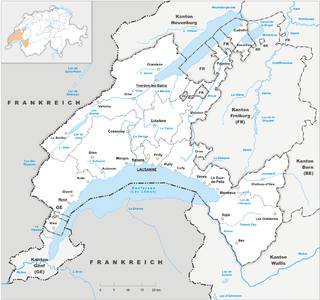
Vaud, more formally the canton of Vaud, is one of the 26 cantons forming the Swiss Confederation. It is composed of ten districts and its capital city is Lausanne. Its coat of arms bears the motto "Liberté et patrie" on a white-green bicolour.
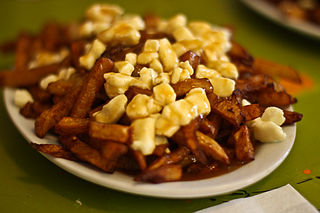
The cuisine of Québec is a national cuisine in the Canadian province of Québec. It is also cooked by Franco-Ontarians.
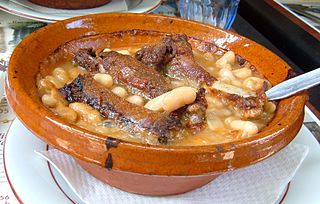
Cassoulet is a rich, slow-cooked stew originating in southern France. The food writer Elizabeth David described it as "that sumptuous amalgamation of haricot beans, sausage, pork, mutton and preserved goose, aromatically spiced with garlic and herbs". It originated in the town of Castelnaudary in the Aude department in the Occitanie region. Variants of the dish are local to other towns and cities in the Aude.

Swiss cuisine is an ensemble of national, regional and local dishes, consisting of the ingredients, recipes and cooking techniques developed in Switzerland or assimilated from other cultures, particularly neighboring countries. The diversity and comprehensiveness of Swiss gastronomy reflects the linguistic, cultural and geographical diversity. The climate of Switzerland allows for a large variety of terroirs, therefore a wide range of indigenous food, from simple cereals to refined products like cheese and wine.

Peasant foods are dishes eaten by peasants, made from accessible and inexpensive ingredients.

Choucroute garnie is an Alsatian recipe for preparing sauerkraut with sausages and other salted meats and charcuterie, and often potatoes.

Czech cuisine has both influenced and been influenced by the cuisines of surrounding countries and nations. Many of the cakes and pastries that are popular in Central Europe originated within the Czech lands. Contemporary Czech cuisine is more meat-based than in previous periods; the current abundance of farmable meat has enriched its presence in regional cuisine. Traditionally, meat has been reserved for once-weekly consumption, typically on weekends.

A potée is a French culinary term which, in general, refers to any preparation cooked in an earthenware pot. More specifically, it refers to a soup or stew made of pork and vegetables, most frequently, cabbage and potatoes of which choucroute is the most characteristic.

Puchero is a type of stew originally from Spain, prepared in Yucatán, Mexico, Argentina, Paraguay, Uruguay, Perú, south of Brazil, the Philippines, and Spain, specifically the autonomous communities of Andalusia and the Canary Islands. The Spanish word "puchero" originally meant an earthenware pot, before being extended to mean any vessel, and then the dish cooked in it.
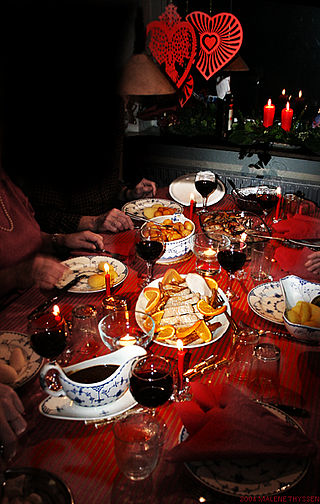
Flæskesteg, ['flɛːskə.stɐ̯j] the Danish version of roast pork, is considered to be one of Denmark's principal national dishes. Always prepared with crackling, it is also a favourite for the Danish Christmas dinner served as the evening meal on 24 December or Christmas Eve.
Marcel Regamey (1905–1982) was a Swiss essayist and journalist from the Canton of Vaud.

Lyonnaise cuisine refers to cooking traditions and practices centering on the area around the French city of Lyon and historical Lyonnais culinary traditions.
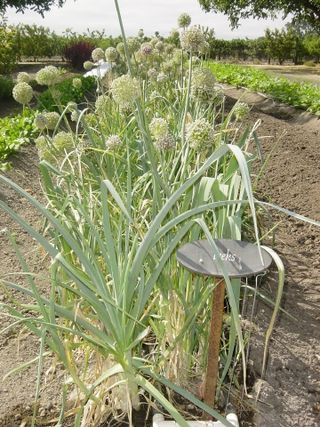
The leek is a vegetable, a cultivar of Allium ampeloprasum, the broadleaf wild leek. The edible part of the plant is a bundle of leaf sheaths that is sometimes erroneously called a stem or stalk. The genus Allium also contains the onion, garlic, shallot, scallion, chive, and Chinese onion. Three closely related vegetables, elephant garlic, kurrat and Persian leek or tareh, are also cultivars of A. ampeloprasum, although different in their uses as food.

Pea soup or split pea soup is soup made typically from dried peas, such as the split pea. It is, with variations, a part of the cuisine of many cultures. It is most often greyish-green or yellow in color depending on the regional variety of peas used; all are cultivars of Pisum sativum.

René Morax was a Swiss writer, playwright, stage director and theatre manager. He founded the Théâtre du Jorat in Morges in 1908, and promoted historical and rural theatre in French in Switzerland. He is known for the play Le Roi David, with music by Arthur Honegger.
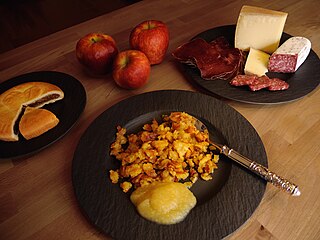
Maluns are a traditional dish of the Grisons, essentially made of potatoes.

Mallorcan soup or Mallorcan dry soup is a typical dish in the gastronomy of the island of Mallorca. It is a rustic dish, often closer in texture to a casserole or very thick stew. It typically is eaten with a fork rather than a spoon.

Sausages and cured meats are widely consumed in Switzerland. Meat in general is consumed on a daily basis, pork being particularly ubiquitous in Swiss cuisine. Preserving meat by smoking it or by adding salt has been done for millennia in Switzerland.


















